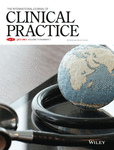Acute intracerebral haemorrhage and diffusion-weighted imaging lesions: A meta-analysis
Funding information
There was no external funding for this study itself. All authors had full access to all of the data in this study and take complete responsibility for the integrity of the data and accuracy of the data analysis.
Abstract
Introduction
Diffusion-weighted imaging lesions in intracerebral haemorrhage are related to a higher risk of recurrent intracerebral haemorrhage, cognitive damage, and mortality. However, it has been reported that the relationship between the risk of diffusion-weighted imaging lesions and intracerebral haemorrhage subtype or the risk factors for diffusion-weighted imaging lesions is variable. This meta-analysis was performed to evaluate this relationship.
Methods
A systematic literature search up-to August 2020 was performed and 12 studies included 2815 subjects at the baseline with intracerebral haemorrhage. They were reporting relationships between the diffusion-weighted imaging lesions and intracerebral haemorrhage subtype or investigated the risk factors for diffusion-weighted imaging lesions. Odds ratio (OR) with 95% confidence intervals (CIs) was calculated to evaluate the prognostic role of diffusion-weighted imaging lesions and intracerebral haemorrhage subtype and investigated the risk factors for diffusion-weighted imaging lesions using the dichotomous and continuous method with a random or fixed-effect model.
Results
Lobar intracerebral haemorrhage was not significantly related to a higher rate of diffusion-weighted imaging lesions (OR, 1.01; 95% CI, 0.75-1.36, P = .94) compared to the non-lobar intracerebral haemorrhage. Also, history of diabetes mellitus (OR, 1.15; 95% CI, 0.83-1.60, P = .39); history of smoking (OR, 0.95; 95% CI, 0.68-1.33, P = .76); history of hypercholesterolaemia (OR, 1.04; 95% CI, 0.73-1.48, P = .83) and history of ischaemic stroke (OR, 1.63; 95% CI, 0.57-4.66, P = .36) were not significantly related to higher rate of diffusion-weighted imaging lesions compared to no history of those factors. However, the history of hypertension was significantly related to a higher rate of diffusion-weighted imaging lesions (OR, 1.33; 95% CI, 1.04-1.70, P = .02) compared to no history of hypertension. Also, Subjects with diffusion-weighted imaging lesions had a greater decrease in systolic pressure in the acute phase of the intracerebral haemorrhage (OR, 10.23; 95% CI, 7.41-13.06, P < .001) compared to without diffusion-weighted imaging lesions.
Conclusions
Based on this meta-analysis, the history of hypertension may have an independent risk relationship with a higher rate of diffusion-weighted imaging lesions. Also, subjects with diffusion-weighted imaging lesions had a greater decrease in systolic pressure in the acute phase of the intracerebral haemorrhage compared to those without diffusion-weighted imaging lesions. This relationship forces us to recommend that identification of diffusion-weighted imaging lesions might add appreciated evidence to evaluate the progression of the underlying micro-angiopathy especially in subjects with a history of hypertension. Though further studies are needed to define the mechanisms by which these lesions may lead to cognitive damage and stroke reappearance.
DISCLOSURES
The authors declare that they have no competing interests.
Open Research
DATA AVAILABILITY STATEMENT
The datasets analysed during this study are available from the corresponding author on reasonable request.




